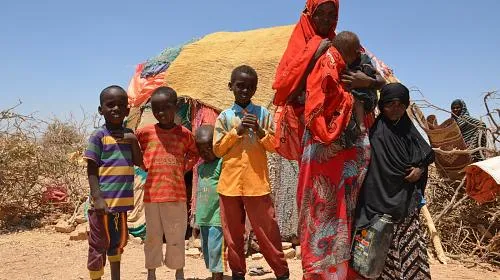New Analysis from Leading Humanitarian, Development and Global Health Organizations Calculates the Devastating Human Costs of Cuts to Foreign Assistance
WASHINGTON, DC (June 15, 2017) – CARE and leading humanitarian, development and health organizations working around the globe have analyzed the Administration’s proposed International Affairs budget for Fiscal Year 2018 (FY 2018) and have estimated that the impact of the proposed cuts would be devastating for the poorest and most vulnerable women, children, and families around the world, as well as for American interests. CARE, Bread for the World, Catholic Relief Services, the International Rescue Committee, InterAction, Mercy Corps, ONE Campaign, Oxfam, PATH, Save the Children, and World Vision strongly urge Congress to reject the President’s foreign affairs budget request and maintain current funding of $60 billion.
Congress is considering the FY 2018 budget and the nomination of Ambassador Mark Green to lead the U.S. Agency for International Development (USAID) in the context of a daunting set of simultaneous and significant global challenges—including famine conditions that threaten the lives of 30 million people, global displacement at an all-time high of 65 million, and more frequent infectious disease outbreaks.
Slashing foreign aid by nearly one-third would shirk America’s longstanding bipartisan commitment to help the world’s most vulnerable people, and would also put the health, security and prosperity of Americans at risk. The deep and disproportionate cuts proposed in the Administration’s FY 2018 International Affairs budget request will have life and death consequences today, and will also undercut America’s – and the world’s – ability to address tomorrow’s global threats.
Sterile statistics on paper are excruciating choices in practice for aid agencies and those we seek to serve in nearly every country around the world. If enacted, the Administration’s FY 2018 budget proposal could result in:
• A 50 percent cut to agricultural development and nutrition, which would in turn deprive 9 million children of lifesaving nutrition interventions and treatments and abandon 5.25 million farmers working to feed their families;
• The complete elimination of (Title II) food aid and of food security programming- during a hunger crisis and famine constituting the most serious humanitarian crisis since World War II- removing access to life-saving food assistance and long-term food security programming from 30 million people;
• A 45 percent cut to water and sanitation programs, resulting in over 2 million people losing access to drinkable water;
• A 53 percent cut to basic education programming – critical to the futures of millions caught in crisis around the world – including the total elimination of basic education funding in Djibouti, Liberia, Malawi, Mozambique, Rwanda, South Africa, Zambia, Burma, Cambodia, Laos, Ukraine, Tajikistan, Dominican Republic, Nicaragua, Peru, Barbados and Eastern Caribbean;
• A 44 percent cut to international disaster assistance, lessening the ability of USAID and partner agencies to reach tens of millions of vulnerable men, women and children with basic humanitarian aid, including over 3 million Yemenis and nearly 2 million Syrians;
• An 18 percent cut to migration and refugee assistance, cutting off 3.5 million refugees and internally-displaced persons from basic assistance, leading to increased displacement and instability;
• A 17 percent cut to the Global Fund to Fight AIDS, TB and Malaria, resulting in the inability to prevent over 4 million new HIV, TB and malaria infections; an 11 percent cut to the President’s Emergency Plan for AIDS relief (PEPFAR), resulting in over 77,000 AIDS-related deaths; and a 10 percent cut to the President’s Malaria Initiative, putting an additional 40 million people at risk of contracting malaria;
• A nearly 8 percent cut to maternal, newborn, and child health funding, which would result in more than 30,000 deaths of mothers and children each year;
• Zero funding for the USAID Emergency Reserve Fund and a 14 percent cut to core global health security programs at the Centers for Disease Control that would increase the likelihood of a global pandemic which is capable of claiming twice as many American lives as the total number of US battlefield fatalities since 1776; and
• A 55 percent cut to gender programs, which would prevent nearly 2 million girls from receiving an education.
In addition to the moral defeat inherent in abandoning millions who rely on lifesaving U.S. assistance around the world, this analysis shows that the impact of these cuts to global humanitarian and development assistance as laid out in the Administration’s budget request, if enacted, would be swift, devastating, and felt for years to come, imperiling millions of lives and the course of global development, stability, and partnership. The U.S. FY 2018 International Affairs budget should match the scale and nature of the global challenges facing America, and reflect the U.S. government’s longstanding bipartisan commitment to shared responsibility and the safeguarding of its own vital interests.
ABOUT CARE:
Founded in 1945, CARE is a leading humanitarian organization fighting global poverty. CARE places special focus on working alongside poor girls and women because, equipped with the proper resources, they have the power to lift whole families and entire communities out of poverty. Last year, CARE worked in 94 countries and reached more than 80 million people around the world. To learn more, please visit www.care.org.
Media Contacts:
Nicole Ellis, +1-202-560-1791, nicole.ellis@care.org

